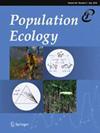Skellam模型的性质和解释——离散时间竞争种群模型
IF 1
4区 环境科学与生态学
Q4 ECOLOGY
引用次数: 0
摘要
Skellam模型描述了单个物种的离散时间种群动态,假设均匀(即随机或泊松)个体分布和种内竞争。除了基于第一原理的基于个体的模型的研究之外,它很少应用于生态研究,尽管在特定情况下,它可能比经常使用的里克模型更合适,例如,里克模型是在假设个体之间的争夺竞争的情况下推导出来的。在本文中,我们深入了解了Skellam模型的基本原理,并根据两个常用参数提供了该模型的另一种参数化方法:人口的内在增长率和承载能力。我们还提供了将Skellam模型拟合到离散人口时间序列数据的指南和软件。鉴于这些发现,Skellam模型可能是一个有用的替代方案,用于一系列之前被忽视的目的。本文章由计算机程序翻译,如有差异,请以英文原文为准。
Properties and interpretation of the Skellam model—A discrete‐time contest competition population model
Abstract The Skellam model describes discrete‐time population dynamics of a single species assuming uniform (i.e., random or Poissonian) individual distribution and intraspecific contest competition. Apart from studies on individual‐based models derived from first principles it has been rarely applied in ecological research although in specific situations it may be more appropriate than, for instance, the frequently used Ricker model, which is derived assuming scramble competition among the individuals. In this article, we offer an insight into the first principles underlying the Skellam model and provide an alternative parameterization of the model in terms of two commonly used parameters: intrinsic rate of population increase and carrying capacity. We also provide guidelines and software for fitting the Skellam model to discrete population time series data. In light of these findings, the Skellam model may be a useful alternative for a range of purposes where it has been earlier overlooked.
求助全文
通过发布文献求助,成功后即可免费获取论文全文。
去求助
来源期刊

Population Ecology
环境科学-生态学
CiteScore
3.90
自引率
11.80%
发文量
41
审稿时长
18-36 weeks
期刊介绍:
Population Ecology, formerly known as Researches on Population Ecology launched in Dec 1952, is the official journal of the Society of Population Ecology. Population Ecology publishes original research articles and reviews (including invited reviews) on various aspects of population ecology, from the individual to the community level. Among the specific fields included are population dynamics and distribution, evolutionary ecology, ecological genetics, theoretical models, conservation biology, agroecosystem studies, and bioresource management. Manuscripts should contain new results of empirical and/or theoretical investigations concerning facts, patterns, processes, mechanisms or concepts of population ecology; those purely descriptive in nature are not suitable for this journal. All manuscripts are reviewed anonymously by two or more referees, and the final editorial decision is made by the Chief Editor or an Associate Editor based on the referees'' evaluations.
 求助内容:
求助内容: 应助结果提醒方式:
应助结果提醒方式:


